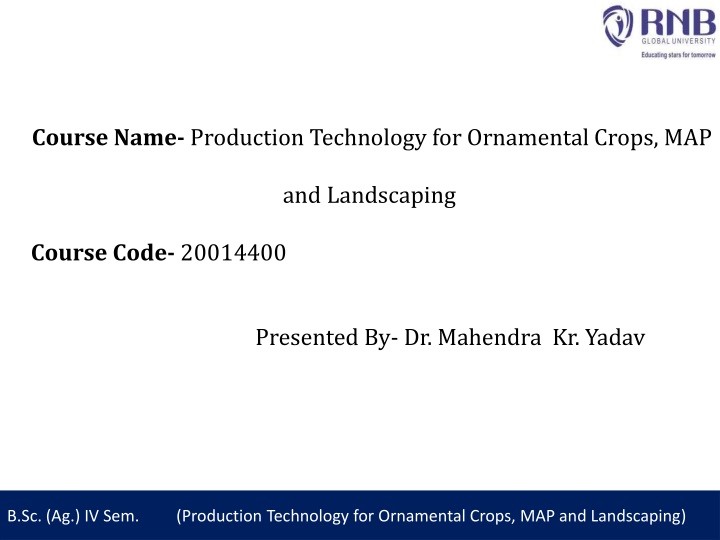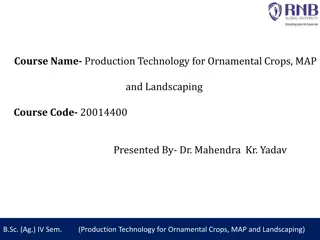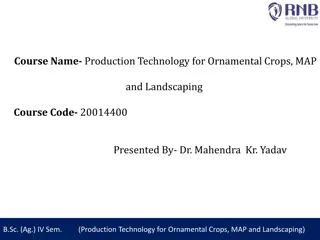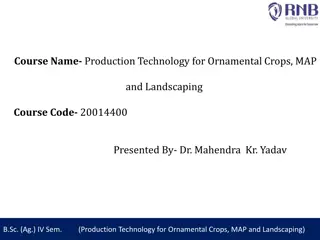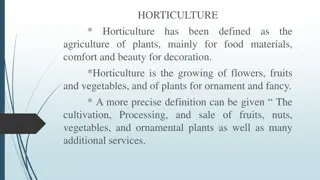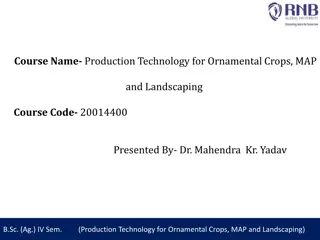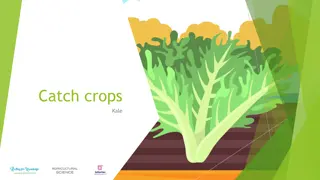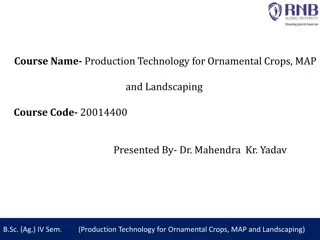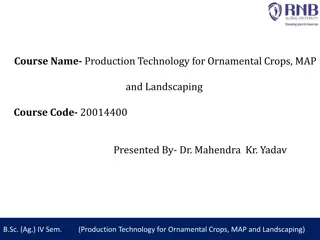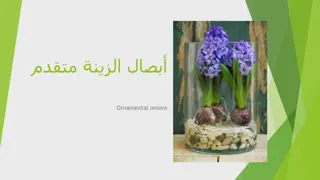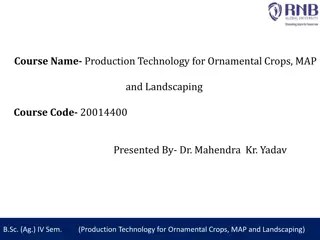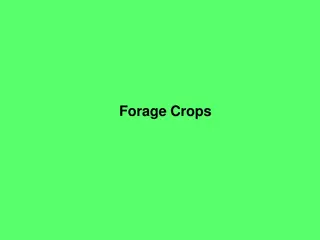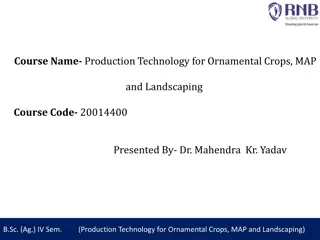Production Technology for Ornamental Crops and Landscaping: Marigold Cultivation
Learn about the production technology for ornamental crops, including identifying different types of plants, landscaping principles, and the cultivation practices for marigold flowers. Explore the characteristics of French and African marigold varieties, their botanical names, climatic and soil requirements, and more. Understand the importance of processing and value addition in ornamental crops. Enhance your knowledge in the field of ornamental horticulture with this informative content.
Download Presentation

Please find below an Image/Link to download the presentation.
The content on the website is provided AS IS for your information and personal use only. It may not be sold, licensed, or shared on other websites without obtaining consent from the author.If you encounter any issues during the download, it is possible that the publisher has removed the file from their server.
You are allowed to download the files provided on this website for personal or commercial use, subject to the condition that they are used lawfully. All files are the property of their respective owners.
The content on the website is provided AS IS for your information and personal use only. It may not be sold, licensed, or shared on other websites without obtaining consent from the author.
E N D
Presentation Transcript
Course Name- Production Technology for Ornamental Crops, MAP and Landscaping Course Code- 20014400 Presented By- Dr. Mahendra Kr. Yadav B.Sc. (Ag.) IV Sem. (Production Technology for Ornamental Crops, MAP and Landscaping)
Course Objectives Identify different types of ornamental and medicinal crops. Examine various principles of landscaping, uses of landscape trees, shrubs and climbers, production technology of important ornamental crops, etc. Determine about Demonstrate various Package of practices for loose flowers and their transportation, storage house and required condition for cut and loose flower. Construct about the various problems with the production technology of medicinal and aromatic plants. Importance of Processing and value addition in ornamental crops B.Sc. (Ag.) IV Sem. (Production Technology for Ornamental Crops, MAP and Landscaping) and MAPs produce. B.Sc. (Ag.) IV Sem. (Production Technology for Ornamental Crops, MAP and Landscaping)
Package of practices for loose flowers -Marigold B.Sc. (Ag.) IV Sem. (Production Technology for Ornamental Crops, MAP and Landscaping)
Marigold Botanical name: French marigold : Tagetus patula African marigold : Tagetus erecta Family : Composite Origin : Central and South America and Mexico Chromosome Number: African marigold 2n= 24 French marigold 2n = 48 B.Sc. (Ag.) IV Sem. (Production Technology for Ornamental Crops, MAP and Landscaping)
Tagetes erecta (African marigold): The African marigold plant is hardy, annual and grows about 90 cm tall, erect and branched. Leaves are pinnately divided and leaflets are lanceolate and serrated. Flowers are single to fully double with large globular heads. Flower colour varies from lemon yellow to yellow, golden yellow or orange. Tagetes patula (French marigold): The French marigold is a hardy annual, grows to about 30 cm tall, forming a bushy plant. Foliage is dark green with reddish stem. Leaves are pinnately divided and leaflets are linear, lanceolate and serrated. Flowers are small, either single or double borne on proportionately long peduncles. The flower colour varies from yellow to mahogany red. B.Sc. (Ag.) IV Sem. (Production Technology for Ornamental Crops, MAP and Landscaping)
Climate: Marigold requires mild climate for luxuriant growth and flower production. The optimum temperature range for its growth is 20 -30 C. Marigold plant survive best in dry and hot condition but very hot climate give adverse effect on flower yield. Soil: Marigold can be grown in a varied type of soils except water logged conditions. But it can be grown best on well drained sandy lome fertile soil. Marigold no need more acidic and alkaline soils with pH 7.0 to 7.5 are suitable for higher production of flower. B.Sc. (Ag.) IV Sem. (Production Technology for Ornamental Crops, MAP and Landscaping)
Land preparation: Ploughing the field 2 to 3 times by the desi plough or tractor with rotavator bring field to fine tilth. During the last ploughing of the field Farm Yard Manure @ 50 ton/hectare or well decomposed cow dung in soil or compost mix in the field. Sowing time: Marigold easily grown three times in a year- Rainy seasons (seed sown in middle of Jun and transplanting seeding during middle of July month). Winter seasons (seed sown in middle August and seeding successful transplanting in middle of September month). Summer seasons (sowing of seed first week of January and then transfer seedling first week of February) hence flowers of marigold can be grown throughout the year. B.Sc. (Ag.) IV Sem. (Production Technology for Ornamental Crops, MAP and Landscaping)
Seed rate and transplanting: For raising seedling, required 1.5 kg seeds/ha. Rising seedling standard size of nursery bed is 3 1 meter. 8 to 10 bed are required for raised seedling for one-hectare transplanting. Seed can be sown by broadcast or line method in nursery. Treat the seeds with Azospirillum before sowing. Before sowing of seed DDT and BHC broadcasted outer side of bed to protect from the ants. Seedlings are transplanted after 28 to 32 days when seedling attained 3 to 5 true type leaf. Propagation by cutting commonly followed for maintain the purity of varieties. Spacing: Spacing should be maintaining in African marigold is 40 30 cm and French marigold 20 20 cm or 20 15cm. B.Sc. (Ag.) IV Sem. (Production Technology for Ornamental Crops, MAP and Landscaping)
Variety: Some specific variety are given below- (1) African Marigold: Climax, Cracker jack, Golden Age, Crown of Gold, Chrysanthemum Charm, Star Gold, Pusa Narangi Genda, Pusa Basanti Genda, Guinea Gold, Apricot, Sun Giants, Primrose, Fiesta, Golden Yellow, Shaggy, Glitters, Mammoth Mum, Happiness, Spun Gold and Cupid. (2) French Marigold: Butter Scotch, Valencia, Rusty Red, Flame, Spry, Star of India, Manure and Fertilizer: Incorporate 40 to 50 tonnes of FYM /hectare during the last ploughing of field. Marigold is one of the commercial flower but research work has not been determining the describe dose of nutrient for growth and flowering. For heights yield of flower N: P: K @100:100:100 kg/ha required at the time of preparation of land and remain 100kg Nitrogen/ha should be applied one month after transplanting of seedling. B.Sc. (Ag.) IV Sem. (Production Technology for Ornamental Crops, MAP and Landscaping)
Weeding and Hoeing: Weed problem in marigold found especially in rainy season. In, India weeding is done manually. Total 3 to 4 times weeding are required during entire growth period marigold. Chemical weed control is also recommended. Irrigation: Irrigation should be given 7 to 8 days interval for obtain higher yield of marigold. In summer season frequent irrigation 4 to 5 days interval required. Water stagnation should be avoided otherwise many diseases are occurred easily and destroyed the entire plant. Pinching in Marigold: Removal of apical portion of shoot is known as pinching. Pinching is a form of pruning that encourages branching of the plant. Pinching forcing the plant to grow more new stems from the leaf nodes below the pinch. First time pinching done at 40 days after transplanting enhances flower yield. Due to pinching maximum yield are obtaining easily. B.Sc. (Ag.) IV Sem. (Production Technology for Ornamental Crops, MAP and Landscaping)
Yield: Flower yield are depending upon the season of planting and cultural practice adopted by former In rainy season fresh flower yield are 200 to 250 quantal/hectare, in winter season 150 to 175 quintal/hectare and 100 to 120 q/ha yield obtain in summer season. Diseases management: Generally marigold crop is free from diseases and insects pest. Occasionally some diseases and insect pests observed are given below. (1) Damping off: Caused by the fungus (Rhizoctonia solani) and major symptoms are brown necrotic spots on young seedlings. Control: Drenching with copper oxychloride @3g/l or brassicol (0.3%). Proper drainage should be provided in the nursery beds. (2) Powdery Mildew: Caused by the fungus Odium sp. and Leveillula taurica. Major symptoms are appearing as grey or white powder and in severe condition leaves turn yellow and fall prematurely. Control: Dusting Kerathane (40 E.C) @ 0.5% or sulphar powder on the plant surface for immediate control. B.Sc. (Ag.) IV Sem. (Production Technology for Ornamental Crops, MAP and Landscaping)
(3) Alternaria leaf spots and Blight: Caused by Alternaria, Cercospora and Septoria. Small brown spot near the lower leaves. Control: Spraying Dithane M-45 2 0.2%. (4) Collar rot: Caused by pythium sp. and phytophthora sp. fungus. Major symptoms of this disease are black lesions on main stem of the plant, rotting at the collar region and destroyed the entire plant. Control: Carbendazim @ 1g/l diminishes the occurrence of collar rot disease. (5) Fusarium Wilt: Wilting in marigold caused by the fungus (Fusarium oxysporum) and wilting of entire plant. Control: Crop rotation is the best way to control wilting in marigold. Carbendazim (0.2%) is effective for wilting. (6) Cucumber mosaic: This is the Viral disease and caused mottling of leaves and busy appearances of plant. Control: Use of Dimethoate at 2 ml/l. B.Sc. (Ag.) IV Sem. (Production Technology for Ornamental Crops, MAP and Landscaping)
Pest management: (1) Red spider mite (Tetranychus sp.): This pest sucks the sap of the plant and then plant are injured badly. Control: Spraying of Kelthane (2 ml/l). (2) Aphid: Attack of aphid on the marigold plant the major symptoms are black or brown spot on the plant appear. Control: Spraying of malathion at 2 ml/l. B.Sc. (Ag.) IV Sem. (Production Technology for Ornamental Crops, MAP and Landscaping)
